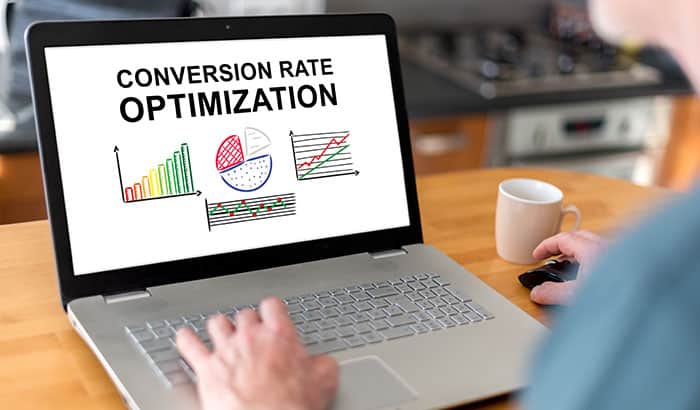In order for online companies to get the most out of their website, they need to implement conversion rate optimization (CRO).
CRO is the process of increasing the percentage of visitors to a website who take a desired action, such as filling out a form or making a purchase.
This process involves analyzing and improving various elements of a website, including the design, layout, and messaging, with the goal of making it as easy and appealing as possible for visitors to take the desired action.
Increasing conversion rates can help businesses gain more web traffic, earn more revenue, and much more. Here are some things to consider if you sell goods or services online.
How CRO Benefits Online Businesses
CRO is a process that can help save business owners time, money, and other resources.
If your conversion rates are lower than you were expecting, or if you want to earn a higher profit margin from your online sales, CRO can help you optimize and improve what you already have.
Here are five specific ways CRO can help you get the most out of your online business.
1. Increase in Revenue:
By increasing the conversion rate, businesses can potentially generate more revenue from their existing traffic. This is because CRO involves identifying and addressing any obstacles or barriers that may be preventing visitors from completing the desired action, such as making a purchase or filling out a form.
By making it easier for visitors to take this action, businesses can increase the number of conversions on their website, which can lead to a boost in revenue.
2. Cost-effective:
CRO can be a cost-effective way to drive growth for businesses. Rather than pouring money into advertising and additional sales tools, using CRO to update your website uses the resources already available and optimizes them for the best possible returns.
This can save businesses money in the long run, as they can focus on making the most of their current traffic rather than constantly trying to attract new visitors. Additionally, the improvements made through CRO can lead to increased conversions, which can offset the cost of the optimization efforts.
3. Improved User Experience:
CRO helps businesses create a better user experience by making it easier for visitors to take the desired action. This can lead to increased customer satisfaction and loyalty.
When visitors have a positive experience on a website, they are more likely to return and recommend it to others.
An added perk is that by addressing any issues or frustrations that visitors may be experiencing, businesses can improve their websites’ overall usability and functionality, which can further enhance the user experience.
4. Increased Competitiveness:
With more businesses competing online, it’s important to stand out and offer a seamless experience to potential customers. This is where conversion rate optimization can come in handy.
By using CRO techniques, businesses can optimize their websites to better meet the needs and expectations of their target audience, which can give them an edge over their competitors.
5. Data-driven Decision-making:
One of the main benefits of CRO is that it allows businesses to make data-driven decisions about their marketing and business strategy. By collecting data on how visitors interact with their websites, businesses can get a better understanding of what works and what doesn’t.
This kind of information can then inform future marketing campaigns and business decisions, helping businesses make more informed and strategic choices about how to allocate their resources and optimize their website for conversions.
Conversion Rate Optimization Best Practices
Here are 10 things companies can do to improve their CRO online:
1. Identify the Desired Action
Clearly define the action you want visitors to take on your website, whether it’s filling out a form, making a purchase, or downloading a resource. Place the call to action somewhere it cannot be missed, like at the top of the web page.
2. Conduct a Website Audit
Analyze your website to identify any areas that may be hindering conversions, such as a cluttered design or unclear messaging. Be sure to prioritize the most important information and the actions with the greatest return.
3. Test and Optimize Website Elements
Use tools like A/B testing to determine which website elements, such as headlines or call-to-action buttons, are most effective in driving conversions. A/B testing can help you discover higher-performing keywords, messages, and formats for your website.
4. Use Social Proof
Display customer testimonials, ratings, and reviews to build trust and credibility with your potential customers. Displaying how others feel about your business can help your target customers feel more confident doing business with you.
5. Improve Website Speed
A slow-loading website can drive visitors away, so make sure your website loads quickly to improve the user experience. The most common offender of website speed are large images. Be sure to shrink them and convert them to web format.
6. Make the Website Mobile-friendly
With more than 50% of people using mobile phones to search online, optimizing your website for mobile to improve the user experience and drive conversions is important. You don’t want to lose out on more than 50% of your potential customers!
7. Simplify the Checkout Process
Make it as easy as possible for customers to complete a purchase by streamlining the checkout process and minimizing the number of steps required. Generally, the harder you make it to do business with you, the less likely people will engage with your business; the opposite can be true.
8. Use Clear and Compelling Calls-to-action
Use action-oriented language and prominent buttons to encourage visitors to take the desired action. Don’t muddy your CTA’s with unnecessary wording; be concise.
9. Personalize the User Experience
Use data and tools like retargeting to deliver personalized messaging and offers to visitors. Emerging AI technology can help you make an experience optimal for your visitors.
10. Monitor and Track Progress
Use tools like Google Analytics to track the performance of your conversion rate optimization efforts and identify areas for improvement. You will learn what is working as you see numbers begin to increase. Continue implementing like strategies as you see your numbers improve.
Optimize Your Conversions With Revity
If you are trying to make the most out of your website but don’t know where to start, our professional assistance may be able to help you.
We specialize in creating and optimizing digital campaigns. We can help your company improve their SEO, increase conversions on Google ads, or see better results from media ads.
Contact us to learn more about how we can help your company.







